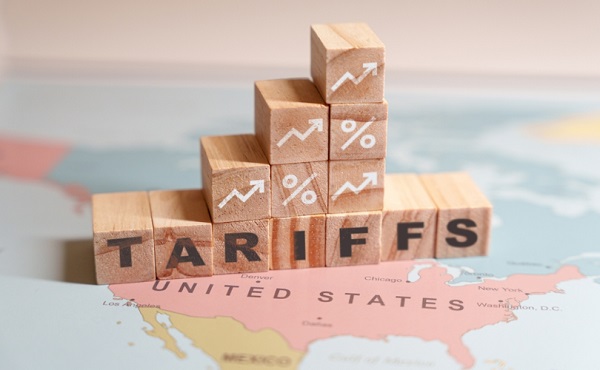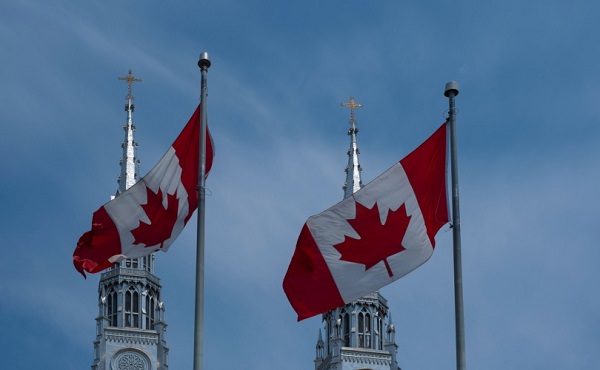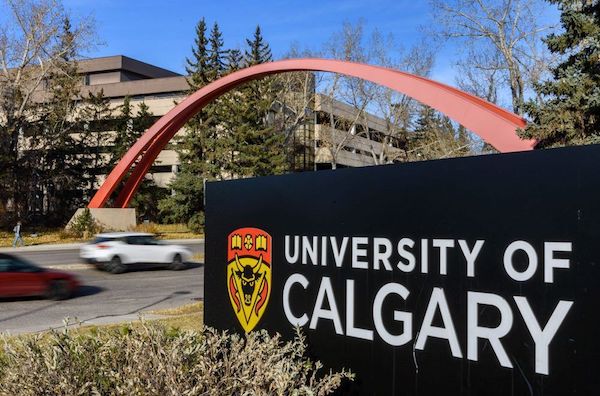Business
Sobering reality check – Trump is right: Canada’s economy can’t survive a fair trade agreement with the US

From LifeSiteNews
Canada’s economy has evolved to completely depend upon the good graces of the USA. If President Trump targets China with punitive tariffs, the Canadian economy will be collaterally damaged.
The current Canadian prime minister is genuinely a walking meme of a Canadian prime minister parody.
During his remarks to Parliament last Thursday, Prime Minister Carney waxed gleefully about the U.S. federal trade court ruling against President Trump’s tariffs, just moments before the federal appeals court stayed the opinion of the lower court. It’s a little funny.
Carney doesn’t seem to recognize the reality of the economic landscape before him. He complains about blocked access to the U.S. consumer base with a level of entitlement that’s genuinely humorous. Meanwhile, the Canadian economy around him is collapsing:
Background
Following the 2024 presidential election, Prime Minister Justin Trudeau traveled to Mar-a-Lago and said if President Trump were to make the Canadian government face reciprocal tariffs, open the USMCA trade agreements to force reciprocity, and/or balance economic relations on non-tariff issues, then Canada would collapse upon itself economically and cease to exist. In essence, in addition to the NATO defense shortfall, Canada cannot survive as a free and independent North American nation, without receiving all the one-way benefits from the U.S. economy.
To wit, President Trump then said, if Canada cannot survive in a balanced rules environment, including putting together its own military and defenses and meeting its NATO obligations, then Canada should become the 51st U.S state.
It was following this meeting that Trump started emphasizing this point and shocking everyone in the process. However, in the emotional reaction to Trump’s statements, no-one looked at the core issues outlined by Trudeau that framed Trump’s opinion.
Representing Canada, Trudeau was not expressing an unwillingness to comply with fairness and reciprocity in trade with the U.S., what Trudeau was expressing was an inability to comply.
Quite simply, after decades of shifting priorities, Canada no longer has the internal economic capability to comply with a fair-trade agreement (FTA). Trudeau was not lying, and Trump understood the argument, hence his 51st state remarks.
This is where it becomes important to understand the core reason why Trump, Ross, and Lighthizer (2017) did not structurally want to replace the NAFTA agreement with another trilateral trade deal. Mexico and Canada are completely different as it pertains to trade with the U.S. President Trump would rather have two separate bilateral agreements; one for Mexico and one for Canada.
Firstly, Canada is a NATO partner, Mexico is not. As Trump affirmed to Trudeau during the meeting, it would be unfair of Trump to discuss NATO funding with the European Union, while Canada is one of the worst offenders. Trump is leveraging favorable trade terms and tariff relief with the EU member states, as a carrot to get them into compliance with the 2.0 percent to 2.5 percent spending requirement for their military.
If NATO member states contribute more to their own defense, the U.S. can pull back spending and save Americans money. However, Canada is currently 26th in NATO funding, spending only 1.37 percent of its GDP on defense.
Canada would have to spend at least another $15 billion/yr on its defense programs in order to reach 2.0 percent. Trudeau told Trump that was an impossible goal given the nature of the Canadian political system, and the current size of its economy ($2.25 trillion).
Secondly, over the last 40 years Canada has deindustrialized its economy, Mexico has not. As the progressive political ideology of its politicians took control of Canada policy, the “climate change” agenda and “green” economy became the focus. The dirty industrialized systems were not compliant with the goals of the Canadian policy makers.
The dirty mining sector (coal, coking coal, ore) no longer exists at scale to support self-sufficient manufacturing. The dirty oil refineries do not exist to refine the crude oil they extract. Large industrial heavy industry no longer exists at a scale needed to be self-sufficient.
Instead, Canada purchases forged and rolled steel component parts from overseas (mostly China). Making the issue more challenging, Canada doesn’t even have enough people skilled to do the dirty jobs within the heavy manufacturing; they would need a national apprenticeship program. Again, all points raised by Trudeau to explain why bilateral trade compliance was impossible.
Thirdly, the trade between Canada/U.S. and Mexico/U.S. is entirely different. The main imports from Canada are energy, lumber, and raw materials. The main imports from Mexico are agriculture, cars, and finished industrial goods. Mexico refines its own oil; Canada ships its oil to the U.S. for refining. There are obviously some similar products from Mexico and Canada, but for the most part there is a big difference.
Fourth, U.S. banks are allowed to operate in Mexico, but U.S. banks are not allowed to operate in Canada. U.S. media organizations are allowed to broadcast in Mexico, but U.S. media organizations are regulated and not permitted to broadcast in Canada. The Canadian government has strong regulations and restrictions on information and intellectual property.
All of these points of difference highlight why a trilateral trade agreement like NAFTA and the USMCA just don’t work out for the U.S.
Additionally, if President Trump levies a tariff on Chinese imports, it hits Canada much harder than Mexico because Canada has deindustrialized and now imports from China to assemble into finished goods destined to the U.S. In a very direct way Canada is a passthrough for Chinese products. Canada is now more of an assembly economy, not a dirty job manufacturing economy.
When Trudeau outlines the inability of Canada to agree to trade terms, simply because his country no longer has the capability of adhering to those trade terms, a frustrated President Trump says, “then become a state.”
There is no option to remain taking advantage of the U.S. on this level, and things are only getting worse. Thus, the point of irreconcilable conflict is identified.
Because the Canadian government became so dependent on its role as an assembly economy, they enmeshed with China in a way that made them dependent. The political issues of Chinese influence within Canada are a direct result of this dynamic. In fact, China was the big winner from the outcome of the recent election because all of their investments into Canada are grounded on retaining Liberal government dependency.
If Trump targets China with punitive tariffs, the Canadian economy will be collaterally damaged. Canada will end up paying a tariff rate because they use cheap Chinese component parts in their finished goods. Canada has structurally designed its economy to do this over multiple years.
Understanding the unique nature of the Canadian economic conundrum, the only way to address the issue is to break out the USMCA into two separate bilateral trade agreements. One set of trade terms for Mexico that leverages border security, and one set of trade terms for Canada that leverages NATO security and border security. The only substantive similarity between them will be in the auto and agriculture sector.
If you think the multinational corporations, political leftists, and UniParty Republicans in the U.S. are strongly opposing Trump now, just wait until later this year when the Trump administration proposes the elimination of the trilateral North American trade agreement, USMCA.
According to the World Bank, the U.S. economy is $27.3 trillion. Canada is $2.1 trillion. Do the math!
From Politico:
The expectation, according to two people close to the White House, is that negotiations to permanently remove the threat of painful 25 percent tariffs on Canada – which Trump mostly rolled back earlier [in April] – and other sector-specific tariffs are likely to be folded into the upcoming review of the U.S.-Mexico-Canada Agreement. That review is due in 2026, but the Trump administration wants to accelerate to this calendar year.
“It makes sense to separate out Canada and Mexico from the rest because they are going to want to redo the USMCA,” said one of the people close to the White House, who were granted anonymity to discuss ongoing deliberations. “They’re going to have separate tariffs that focus specifically on Mexico and Canada, and they’re going to take some actions to squeeze them a little bit.”
Reprinted with permission from Conservative Treehouse.
Business
Conservative MPs denounce Liberal plan to strip charitable status of pro-life, Christian groups

From LifeSiteNews
Conservative MPs presented a petition in Parliament defending pro-life charities and religious organizations against a Liberal proposal to strip their charitable tax status.
Conservative MPs presented a petition calling for the rejection of the Liberals’ plan to strip pro-life charities and places of worship of their charitable status.
During the September 16 session, Conservative Members of Parliament (MPs) Andrew Lawton, Jacob Mantle, and Garnett Genuis defended pro-life charities and places of worship against Liberal recommendations to remove the institutions’ charitable status for tax purposes.
“I have received from houses of worship across this country so much concern, reflected in this petition, that these recommendations are fundamentally anti-free speech and anti-religious freedom,” Lawton told Parliament. “The petitioners, and I on their behalf, advocate for the complete protection of charitable status regardless of these ideological litmus tests.”
Similarly, Mantle, a newly elected MP, added that Canadians “lament that some members opposite are so blinded by their animus towards charitable organizations that they would seek to undermine the good works that these groups do for the most vulnerable Canadians.”
Religious charities provide care and compassion to the most vulnerable in our society, but some members of the Liberal and New Democratic parties are so blinded by their animus towards religion and faith that they are actively seeking to revoke the charitable status of ALL… pic.twitter.com/O12rkw3pJ0
— Jacob Mantle (@jacobmantle) September 16, 2025
Finally, Genuis, who officially presented the petition signed by hundreds of Canadians, stressed the importance work accomplished by religious and pro-life organizations.
“(R)eligious charities in Canada provide vital services for society, including food banks, care for seniors, newcomer support, youth programs and mental health outreach, all of which is rooted in their faith tradition, and that singling out or excluding faith charities from the charitable sector based on religious belief undermines the diversity and pluralism foundational to Canadian society,” he explained.
As LifeSiteNews previously reported, before last Christmas, a proposal by the all-party Finance Committee suggested legislation that could strip pro-life pregnancy centers and religious groups of their charitable status.
The legislation would amend the Income Tax Act and Income Tax. Section 429 of the proposed legislation recommends the government “no longer provide charitable status to anti-abortion organizations.”
The bill, according to the finance department, would require “registered charities that provide services, advice, or information in respect of the prevention, preservation, or termination of pregnancy (i.e., destroying the unborn)” to disclose that they “do not provide specific services, including abortions or birth control.”
Similarly, Recommendation 430 aims to “amend the Income Tax Act to provide a definition of a charity which would remove the privileged status of ‘advancement of religion’ as a charitable purpose.”
Many Canadians have warned that the proposed legislation would wipe out thousands of Christian churches and charities across Canada.
As LifeSiteNews reported in March, the Canadian Conference of Catholic Bishops (CCCB) appealed to the Liberal government to rethink the plan to strip pro-life and religious groups of their tax charity status, stressing the vital work done by those organizations.
Business
The Real Reason Tuition Keeps Going Up at Canada’s Universities

Since 2020, steep increases to tuition fees have triggered large-scale protests by the students who pay those fees at the University of Alberta, University of Calgary, University of British Columbia and at McGill University and Concordia University in Quebec, among many other schools. (A freeze on tuition fees in Ontario since 2019 explains that province’s absence from the list.)
It’s true that tuition has been on the rise. According to Statistics Canada , between 2006-2007 and 2024-2025, the average undergraduate full-year tuition fee at a Canadian university grew from approximately $4,900 to $7,360.
But do the students really know what’s behind the increases?
University administrators looking to deflect responsibility like to blame provincial government cutbacks to post-secondary funding. Here, the evidence is unconvincing. Going back two decades, nationwide full-time equivalent (FTE) student transfer payments from provincial governments have remained essentially constant, after accounting for inflation. While government grants have remained flat, tuition fees are up.
The issue, then, is where all this extra money is going – and whether it benefits students. Last year researcher and consultant Alex Usher took a close look at the budgeting preferences of universities on a nationwide basis. He found that between 2016-2017 and 2021-2022 the spending category of “Administration” – which comprises the non-teaching, bureaucratic operations of a university – grew by 15 percent. Curiously enough “Instruction,” the component of a university that most people would consider to be its core function, was among the slowest growing categories, at a mere 3 percent. This top-heavy tendency for universities is widely known as “administrative bloat”.
Administrative bloat has been a problem at Canadian universities for decades and the topic of much debate on campus. In 2001, for example, the average top-tier university in Canada spent $44 million (in 2019 dollars) on central administration. By 2019 this had more than doubled to $93 million, supporting Usher’s shorter-term observations. Usher calculated that the size of the non-academic cohort at universities has increased by between 85 percent and 170 percent over the past 20 years.
While some level of administration is obviously necessary to operate any post-secondary institution, the current scale and role of campus bureaucracies is fundamentally different from the experience of past decades. The ranks of university administration used to be filled largely with tenured professors who would return to teaching after a few terms of service. Today, the administrative ranks are largely comprised of a professional cadre of bureaucrats. (They are higher paid too; teaching faculty are currently paid about 10 percent less than non-academic personnel.)
This ever-larger administrative state is increasingly displacing the university’s core academic function. As law professor Todd Zywicki notes, “Even as the army of bureaucrats has grown like kudzu over traditional ivy walls, full-time faculty are increasingly being displaced by adjunct professors and other part-time professors who are taking on a greater share of teaching responsibilities than in the past.” While Zywicki is writing about the American experience, his observations hold equally well for Canada.
So while tuition fees keep going up, this doesn’t necessarily benefit the students paying those higher fees. American research shows spending on administration and student fees are not correlated with higher graduation rates. Canada’s huge multi-decade run-up in administrative expenditures is at best doing nothing and at worst harming our universities’ performance and reputations. Of Canada’s 15 leading research universities, 13 have fallen in the global Quality School rankings since 2010. It seems a troubling trend.
And no discussion of administrative bloat today can ignore the elephant in the corner: diversity, equity and inclusion (DEI). Writing in the National Post, Peter MacKinnon, past president of the University of Saskatchewan, draws a straight line from administrative bloat to the current infestation of DEI policies on Canadian campuses.
The same thing is going on at universities across Canada that have permanent DEI offices and bureaucracies, including at UBC, the University of Calgary, University of Waterloo, Western University, Dalhousie University and Thompson Rivers University. As a C2C Journal article explains, DEI offices and programs offer no meaningful benefit to student success or the broader university community. Rather, they damage a school’s reputation by shifting focus away from credible scientific pursuits to identity politics and victimology.
With universities apparently unable to restrain the growth of their administrative Leviathan, there may be little alternative but to impose discipline from the outside. This should begin with greater transparency.
Former university administrator William Doswell Smith highlights a “Golden Rule” for universities and other non-profit institutions: that fixed costs (such as central administration) must never be allowed to rise faster than variable costs (those related to the student population). As an example of what can happen when Smith’s Golden Rule is ignored, consider the fate of Laurentian University in Sudbury, Ontario.
In early 2021 Laurentian announced it was seeking bankruptcy protection under the Companies’ Creditors Arrangement Act, under which a court-appointed manager directs the operations of the delinquent organization. Laurentian then eliminated 76 academic programs, terminated 195 staff and faculty, and ended its relationships with three nearby schools.
Ontario’s Auditor-General Bonnie Lysak found that the primary cause of the school’s financial crisis were ill-considered capital investments. The administrators’ big dreams essentially bankrupted the university.
The lesson is clear: if universities refuse to correct the out-of-control growth of their administrations, then fiscal discipline will eventually be forced upon them. A reckoning is coming for these bloated, profligate schools. The solution to higher tuition is not increasing funding. It’s fewer administrators.
The original, full-length version of this article was recently published in C2C Journal.
Jonathan Barazzutti is an economics student at the University of Calgary. He was the winner of the 2nd Annual Patricia Trottier and Gwyn Morgan Student Essay Contest co-sponsored by C2C Journal.
-

 Alberta1 day ago
Alberta1 day agoSylvan Lake high school football coach fired for criticizing gender ideology sends legal letter to school board
-

 International8 hours ago
International8 hours agoTrump sues New York Times for $15 billion over ‘malicious, defamatory’ election coverage
-

 Energy1 day ago
Energy1 day agoA Breathtaking About-Face From The IEA On Oil Investments
-

 Alberta2 days ago
Alberta2 days agoParents group blasts Alberta government for weakening sexually explicit school book ban
-

 COVID-191 day ago
COVID-191 day agoFreedom Convoy leader slams Canadian gov’t agency for praising its treatment of protesters
-

 Frontier Centre for Public Policy2 days ago
Frontier Centre for Public Policy2 days agoBloodvein Blockade Puts Public Land Rights At Risk
-

 Business2 days ago
Business2 days agoOttawa’s so-called ‘Clean Fuel Standards’ cause more harm than good
-

 International2 days ago
International2 days agoFrance records more deaths than births for the first time in 80 years



